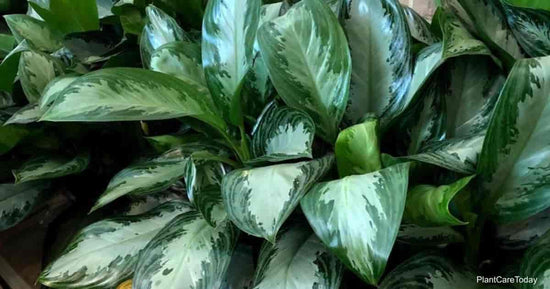The Rattlesnake Plant makes an attractive addition to a tabletop or shelf with its expansive yet compact silhouette. Native to tropical Brazil, these impressive plants will reward you for consistent care.
Maintenance: Intermediate | Climate: Warm + Humid | Light: Medium + Indirect | Watering: Consistent | Pet Safe: Yes
CHARACTERISTICS
Leaves on the Rattlesnake Plant grow narrow and oval-shaped with wavy edges, reaching up to 30 inches tall over their lifetime. Their name comes from the leaf pattern resembling that of a rattlesnake, with small, alternating dark-green ovals along the midrib. These plants perform a fascinating daily act of opening their leaves in response to daylight and shutting them again at nighttime. This reveals the beautiful reddish-purple shade underneath their leaves.
LIGHT
Rattlesnake Plants prefer medium and indirect light, even adapting to some low light conditions. Light that is too bright or direct will bleach the leaves of their color. They would do well placed away from windows, in corners, and rooms with north-facing windows.
WATER
Water the Rattlesnake enough to keep it moist regularly, but not oversaturated. When the top 1-2 inches of soil have tried, water well and be sure to reduce the frequency during Fall and Winter. Never allow the potting soil to dry out completely and only use non-tap water.
AIR
Create a tropical environment by maintaining warm temperatures and offering your Rattlesnake Plant an extra boost of humidity. It should also be kept away from drafts, vents, and cold temperatures.
Boost humidity around your plant by:
- Misting the leaves 2-4x per week
- Placing a Pebble Tray underneath the pot
- Adding a humidifier nearby
- Placing in a bathroom or kitchen
PLACEMENT
The Rattlesnake Plant is part of the Calathea family, which symbolizes new beginnings. The act of expanding its leaves at the start of the day reminds us to approach each day with a fresh heart and mind.
They make lovely gifts to mark the start of new chapters and life transitions.
POTTING & SOIL
Depending on how fast your Rattlesnake grows, it can go 1-2 years without needing to be repotted into a larger pot size. It will benefit from refreshing the topsoil at the start of every growing season with optional fertilizer treatment about every 4 weeks.
A ceramic planter up to 2” larger and with a drainage hole is ideal for maintaining moisture balance for the Rattlesnake. Additionally, well-draining soil with amendments such as perlite, sand, or coco coir will both retain moisture and increase aeration.
SEASONAL CARE
Reduce watering frequency through Fall and Winter while the plant rests and the soil dries slower. If they’re on a windowsill, they may need to be moved a few feet away to avoid cold drafts. Proximity to air vents should also be avoided.
At the start of Spring, gradually increase your watering frequency again and fertilize every 4 weeks. Do not fertilize for at least 6 weeks after it has been repotted.
PRUNING & PROPAGATION
Leaves may need to be removed from time to time if they are damaged, old, or dead. To do so, use a clean pair of scissors to cut the leaf close to the soil. It’s also common for just the leaf tips to turn brown under dry conditions, in which case, the brown alone can be carefully trimmed using clean scissors. Cut in the natural leaf shape and avoid cutting into any healthy green.
Rattlesnake plants are best propagated by division at the roots. Remove the plant from the pot and massage away excess soil. Where roots are well developed, separate the plant in two sections using your hands or a clean and sharp knife. Repot in a new pot using some of its original soil and maintain similar care with high humidity for a smooth transition.
COMMON ISSUES
Changes in the appearance of a Rattlesnake Plant are commonly due to improper moisture levels. Some other changes you might see are:
BROWN, DRY, OR CURLING LEAVES
Brown tips and edges or dry, curling leaves on a Rattlesnake are a sign of low moisture levels. This can come as a result of dry air or dry soil. Be sure to maintain consistently moist soil and boost humidity levels around your plant.
YELLOW OR DROOPING LEAVES
Droopy or yellow leaves on a Rattlesnake Plant are commonly a sign of overwatering. Soil should be kept moist, allowing the top 1-2” to dry before being watered again. These can also be a sign of poor drainage in the soil or pot. As the plant develops new growth, it’s expected that some older leaves may yellow and die off as well.
LEAF LOSS
If your Rattlesnake Plant is losing leaves, it’s a general sign of stress, usually from cold temperatures, drafts, or shock after transport. This can also be a sign of over or underwatering.
BLEACHED LEAVES
If the light exposure is too harsh or direct for your Rattlesnake, the leaves will become bleached and result in a loss of color and leaf pattern. Trim off any damaged, dry pieces and move your plant into medium, indirect light.
SPOTS ON LEAVES
Spots developing on Rattlesnake leaves are often due to poor water quality or low humidity levels. Tap water should only be used after it has been left out overnight to allow harsh minerals to evaporate. Additionally, boost humidity levels using the tips in the “Air” section above.
A fungal infection can also show as spots on leaves. One sign of leaf fungus is a spot that continues to grow on the leaf and spread across the plant fairly quickly. Treat leaf fungus with a repeated antifungal spray on the leaves.
LEAVES HAVE STOPPED OPENING
Calatheas naturally open and close their leaves in response to daylight and night, respectively. If your Rattlesnake plant has stopped unfolding itself when exposed to light, it could be a result of dry soil, low humidity, or lighting that is too bright.
PRO TIPS
- Keep the leaves free of dust for optimal photosynthesis and air purification.
- Room temperature or lukewarm water is preferred for this tropical plant.
- A planter with a drainage hole will be best to ensure the soil dries out efficiently after each generous watering.
—----
Have any specific care questions about your Rattlesnake Plant? Schedule an Office Hours call with our Plant Specialist - free for all Grounded customers!





